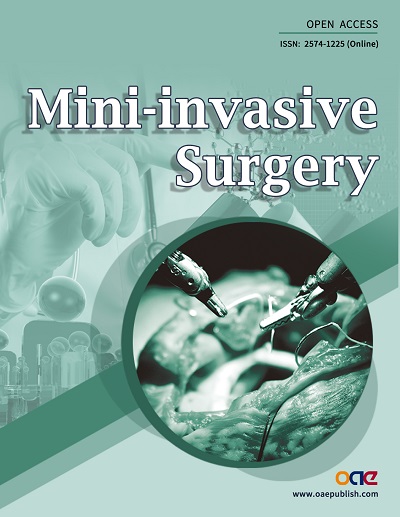Has robotic prostatectomy determined the fall of the laparoscopic approach?
Abstract
Robotic-assisted laparoscopic prostatectomy (RALP) has revolutionised the surgical management of localised prostate cancer in the modern era. The surgeon is provided with greater precision, more versatile dexterity and an immersive three-dimensional visual field. The impressive hardware facilitates, for example, the dissection of the peri-prostatic fascia, whilst preserving the neurovascular bundle, or the suturing of the vesico-urethral anastomosis. Prior to RALP, laparoscopic radical prostatectomy (LRP) represented the first venture into the minimally invasive world. Associated with more cumbersome ergonomics, LRP has a significant learning curve compared with the robotic approach. There has been a paucity, until recently, of high-quality literature comparing outcomes between the two operations, including the attainment of the Pentafecta of survivorship: biochemical recurrence-free, continence, potency, no postoperative complications and negative surgical margins.
Keywords
Today, the majority of men with intermediate or high-risk localised prostate cancer, who are candidates for surgical intervention, will undergo a robotic-assisted laparoscopic prostatectomy (RALP). The robot has firmly cemented itself as the modality of choice for both patients and urologists.
Prior to the current era of minimally invasive surgery, the standard approach was open radical prostatectomy. The postoperative morbidity associated with the procedure however led surgeons to explore less invasive approaches. Laparoscopic radical prostatectomy (LRP) subsequently gained traction with the prospect of smaller incisions, less bleeding, fewer postoperative complications and reduced length of hospital stay[1]. The new anatomical perspective encountered, manipulation required for suturing and cumbersome ergonomics no doubt proved challenging, particularly for laparoscopic naïve surgeons. Perhaps akin to “painting one’s hallway through the letterbox” and associated with a steep learning curve, many urologists opted to continue their open prostatectomy practice. A more attractive option was needed.
Since the turn of the millennium, the emergence of robotic technology has led to a new dawn in urological practice. The first RALP was undertaken in 2000, by Binder et al.[2], at the Department of Urology of Frankfurt University.
Perhaps a misnomer, a better description of the robotic approach would be “enhanced laparoscopic surgery”. Comprising a surgeon console, patient cart and vision cart, the surgeon is provided with improved ergonomics, more versatile dexterity, beyond that of the human wrist, and enhanced three-dimensional high-definition optics. The impressive hardware has been further complemented, in recent iterations, with innovative software such as tremor filtration and intraoperative fluorescence imaging. The da Vinci system, manufactured by Californian based company Intuitive, is synonymous with robotic surgery and has remained the market leader since launching in 1999. Prostatectomy lends itself to the robot. The improved visualisation, for the dissection of the peri-prostatic fascia, down the deep male pelvis, and the resultant precision it allows, facilitating the preservation of the neurovascular tissue for nerve-sparing approaches, and the suturing of the vesico-urethral anastomosis. The anatomy of the prostate is so clearly visualised and appreciated. Ashutosh Tewari offers a helpful analogy whilst arguing the case for the robotic approach, with its improved visuals, in the Wall Street Journal (2018): “When Swiss watchmakers start working in the dark, relying on tactile feedback and not magnifying glasses, then we’ll believe that surgery should be done by touch and not by direct visualisation of the anatomical structures”.
The training of the future generation of minimally invasive surgeons is complimented with robotics. The learning curve is significantly less daunting and steep, with reported minimum numbers of 40 compared to 200-750 cases for RALP and LRP respectively. Even for the laparoscopic naïve surgeon, following the completion of 100 RALPs, the evidence would allude to a significant reduction in operating time, estimated blood loss and complications[3]. Another aspect of the debate to consider, and perhaps not greatly acknowledged, is the impact operating might have on our physical health. A significant number of surgeons report musculoskeletal discomfort, impairing longevity and potentially catalysing early retirement. The awkwardness associated with the laparoscopic approach contrasts with the adjustable robotic surgical console. Surgeons when surveyed are in agreement; robotic surgery is a more comfortable experience that enables mitigation of these occupational ailments[4].
Fundamentally it is the patient who should derive most benefit from any difference between techniques. The Trifecta of prostate cancer survivorship consists of (1) biochemical recurrence-free (2) urinary continence and (3) sexual potency. A Pentafecta has more recently been proposed that includes (4) no postoperative complications and (5) negative surgical margins[5].
To date, there is a paucity of high-quality literature assessing these 5 pillars of outcome between RALP and LRP. The LAP01 (2021) Randomised Controlled Trial attempted to address this. Heralded as the first patient blinded, multi-centre and multi-surgeon study (RALP n = 586, LRP n = 196). Given the widespread acceptance of RALP in Germany, both patients and families tend to self-select the robot. Stolzenburg et al.[6] randomised at a ratio of 3:1, in favour of RALP, to combat this. Superior continence rates, defined as “no use of pads or use of a single safety pad”, at 3-month follow-up were demonstrated with RALP (54% vs. 46%, P = 0.027). This difference was amplified when adjustments were made for bilateral nerve-sparing approaches (66% vs. 50%, P = 0.005). Secondary outcomes included continence rates as assessed via the validated International Consultation on Incontinence-Short Form Questionnaire (ICIQ-SF). Again, a significant difference was demonstrated at 3-month review with RALP (ICIQ sum scores P = 0.003). Despite being primarily powered for assessment of continence recovery, recovery of potency (erections sufficient for intercourse) at early 3-month follow up did demonstrate a significant improvement with the robotic technique (18% vs. 6.7%, P = 0.007). No significant differences in early oncological outcomes were documented[6].
Prior to LAP01, Asimakopoulos et al.[7] (RALP n = 64, LRP n = 64) illustrated a significantly improved 12-month evaluation of capability for intercourse (77% vs. 32%, P < 0.0001) with RALP compared to LRP in their single surgeon series. The improved potency was not associated with impaired oncological outcomes[7]. Porpiglia et al.[8] (RALP n = 60 and LRP n = 60) demonstrated improved 1-year urinary continence rates (95% vs. 83.3%, P = 0.042) and more favourable rates of erection recovery at 1-year, among pre-operative potent patients treated with nerve-sparing approaches (80% vs. 54.2%, P = 0.020).
In a recent meta-analysis, Wang et al.[9] (2018) assessed 8 retrospective case series to date comparing the two techniques. Reduced rates of postoperative complications (including anastomotic leakage, anastomotic stenosis, rectal injury, urinary incontinence, and erectile dysfunction) and improved urinary continence rates, at 1-year follow-up, were reported with RALP (P < 0.00001)[9].
On reflection, RALP will remain the standard-of-care approach. Postoperative complications are reduced, functional outcomes are improved (both continence and potency), and negative surgical margin rates are at least comparable[10]. We await long term data post-prostatectomy, including biochemical recurrence-free rates between the techniques, and anticipate the late oncological outcomes from the LAP01 study. The robotic operative techniques will be honed, instruments enhanced, and further innovative software released, with an ever-increasing weaving of technology into the fabric of the operating theatre.
Albeit associated with significant up-front expenditure, when one considers the cumulative long-term health care costs, including the management of postoperative complications and functional outcomes, the argument is more nuanced, particularly in high-volume RALP centres. The higher index hospitalisation costs appear to be offset by the post-RALP health gains[11]. There exists however, a considerable inequality gap between those centres across the globe that can afford robotic technologies and those that cannot. One hopes that over the forthcoming years challenger companies will emerge, competitive pricing ensues, and the robotic platform with its associated operating theatre costs will continue to dissipate.
Ultimately, let us not become too reliant on the impressive robotic technology at our disposal to achieve optimal postoperative outcomes. The attainment of the Pentafecta post-radical prostatectomy is reliant on a myriad of factors that include the comorbid status of our patients, the disease characteristics and most vitally, the guile, skill and experience of the urologist. The robot has not quite determined the fall of the surgeon.
DECLARATIONS
Authors’ contributionsMade substantial contributions to article write-up: Hayes J, Vasdev N, Dasgupta P
Availability of data and materialsNot applicable.
Financial support and sponsorshipNone.
Conflicts of interestAll authors declared that there are no conflicts of interest.
Ethical approval and consent to participateNot applicable.
Consent for publicationNot applicable.
Copyright© The Author(s) 2021.
REFERENCES
1. Schuessler WW, Schulam PC, Clayman RV. Laparoscopic radical prostatectomy: initial case report. J Urol 1992;147:246-8.
2. Binder J, Kramer W. Robotically-assisted laparoscopic radical prostatectomy. BJU Int 2001;87:408-10.
3. Abboudi H, Khan MS, Guru KA, et al. Learning curves for urological procedures: a systematic review. BJU Int 2014;114:617-29.
4. Plerhoples TA, Hernandez-Boussard T, Wren SM. The aching surgeon: a survey of physical discomfort and symptoms following open, laparoscopic, and robotic surgery. J Robot Surg 2012;6:65-72.
5. Patel VR, Sivaraman A, Coelho RF, et al. Pentafecta: a new concept for reporting outcomes of robot-assisted laparoscopic radical prostatectomy. Eur Urol 2011;59:702-7.
6. Stolzenburg JU, Holze S, Neuhaus P, et al. Robotic-assisted versus laparoscopic surgery: outcomes from the first multicentre, randomised, patient-blinded controlled trial in radical prostatectomy (LAP-01). Eur Urol 2021;79:750-9.
7. Asimakopoulos AD, Pereira Fraga CT, Annino F, Pasqualetti P, Calado AA, Mugnier C. Randomized comparison between laparoscopic and robot-assisted nerve-sparing radical prostatectomy. J Sex Med 2011;8:1503-12.
8. Porpiglia F, Morra I, Lucci Chiarissi M, et al. Randomised controlled trial comparing laparoscopic and robot-assisted radical prostatectomy. Eur Urol 2013;63:606-14.
9. Wang T, Wang Q, Wang S. A Meta-analysis of robot assisted laparoscopic radical prostatectomy versus laparoscopic radical prostatectomy. Open Med (Wars) 2019;14:485-90.
10. Porpiglia F, Fiori C, Bertolo R, et al. Five-year outcomes for a prospective randomised controlled trial comparing laparoscopic and robot-assisted radical prostatectomy. Eur Urol Focus 2018;4:80-6.
11. Close A, Robertson C, Rushton S, et al. Comparative cost-effectiveness of robot-assisted and standard laparoscopic prostatectomy as alternatives to open radical prostatectomy for treatment of men with localised prostate cancer: a health technology assessment from the perspective of the UK National Health Service. Eur Urol 2013;64:361-9.
Cite This Article
How to Cite
Hayes, J.; Vasdev, N.; Dasgupta, P. Has robotic prostatectomy determined the fall of the laparoscopic approach?. Mini-invasive. Surg. 2021, 5, 56. http://dx.doi.org/10.20517/2574-1225.2021.126
Download Citation
Export Citation File:
Type of Import
Tips on Downloading Citation
Citation Manager File Format
Type of Import
Direct Import: When the Direct Import option is selected (the default state), a dialogue box will give you the option to Save or Open the downloaded citation data. Choosing Open will either launch your citation manager or give you a choice of applications with which to use the metadata. The Save option saves the file locally for later use.
Indirect Import: When the Indirect Import option is selected, the metadata is displayed and may be copied and pasted as needed.
About This Article
Special Issue
Copyright
Data & Comments
Data















Comments
Comments must be written in English. Spam, offensive content, impersonation, and private information will not be permitted. If any comment is reported and identified as inappropriate content by OAE staff, the comment will be removed without notice. If you have any queries or need any help, please contact us at support@oaepublish.com.